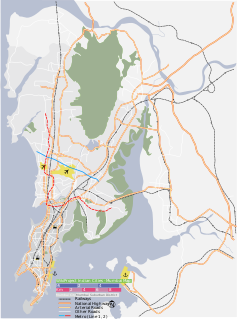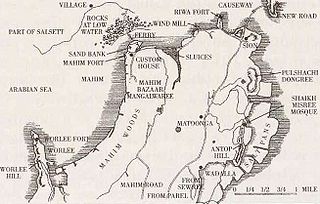Related Research Articles

Mumbai is the capital city of the Indian state of Maharashtra. According to the United Nations, as of 2018, Mumbai is the second-most populous city in India after Delhi and the seventh-most populous city in the world with a population of roughly 20 million. As per the Indian government population census of 2011, Mumbai was the most populous city in India with an estimated city proper population of 12.5 million living under Municipal Corporation of Greater Mumbai. Mumbai is the centre of the Mumbai Metropolitan Region, the sixth most populous metropolitan area in the world with a population of over 23 million. Mumbai lies on the Konkan coast on the west coast of India and has a deep natural harbour. In 2008, Mumbai was named an alpha world city. It has the highest number of millionaires and billionaires among all cities in India. Mumbai is home to three UNESCO World Heritage Sites: the Elephanta Caves, Chhatrapati Shivaji Maharaj Terminus, and the city's distinctive ensemble of Victorian and Art Deco buildings designed in the 19th and 20th centuries.

The Mumbai Police is the police department of the city of Mumbai, Maharashtra. It is a part of Maharashtra Police and has the primary responsibilities of law enforcement and investigation within the limits of Mumbai. The force's motto is "Sadrakṣaṇāya Khalanigrahaṇāya".

The Central Provinces and Berar was a province of British India and later the Dominion of India which existed from 1903 to 1950. It was formed by the merger of the Central Provinces with the province of Berar, which was territory leased by the British from the Hyderabad State. Through an agreement signed on 5 November 1902, 6th Nizam Mahbub Ali Khan, Asaf Jah VI leased Berar permanently to the British for an annual payment of 25 lakhs Rupees. Lord Curzon decided to merge Berar with the Central Provinces, and this was proclaimed on 17 September 1903.

Bombay State was a large Indian state created at the time of India's Independence, with other regions being added to it in the succeeding years. Bombay Presidency was merged with the princely states of Baroda, Western India and Gujarat and the Deccan States.

The Mazagaon Fort was a British fort in Mazagaon, Bombay, in the Indian state of Maharashtra, built around 1680. The fort was razed by the Muslim Koli general, Yakut Khan in June 1690. The fort was located at the present-day Joseph Baptista Gardens, atop Bhandarwada Hill outside the Dockyard Road railway station.

Jalgaon is a district in the northern part of Maharashtra, India. The headquarters is the city of Jalgaon.

The Provinces of India, earlier Presidencies of British India and still earlier, Presidency towns, were the administrative divisions of British governance in the Indian subcontinent. Collectively, they have been called British India. In one form or another, they existed between 1612 and 1947, conventionally divided into three historical periods:

Maharashtra Day, commonly known as Maharashtra Din is a state holiday in the Indian state of Maharashtra, commemorating the formation of the state of Maharashtra from the division of the Bombay State on 1 May 1960. Maharashtra Day is commonly associated with parades and political speeches and ceremonies, in addition to various other public and private events celebrating the history and traditions of Maharashtra. It is celebrated to commemorate the creation of a Marathi speaking state of Maharashtra.
Pune is the 9th most populous city in India and the second-largest in the state of Maharashtra, after the state capital Mumbai. The history of the city is closely related to the rise of the Maratha empire from the 17th–18th century. During the 18th century, Pune became the political centre of the Indian subcontinent; as the seat of the Peshwas, who were the prime ministers of the Maratha Empire.
Human habitation of Mumbai/Bombay existed since the Stone Age, the Kolis and Aagri were the earliest known settlers of the islands. The Maurya Empire gained control of the islands during the 3rd century BCE and transformed it into a centre of Hindu-Buddhist culture and religion. Later, between the 2nd century BCE and 9th century CE, the islands came under the control of successive indigenous dynasties: Satavahanas, Abhiras, Vakatakas, Kalachuris, Konkan Mauryas, Chalukyas and Rashtrakutas, before being ruled by the Silharas from 810 to 1260.
The history of Mumbai under Islamic rule began in 1348 and continued until 1534.

Bombay, now called Mumbai, Bombaim in Portuguese, is the financial and commercial capital of India and one of the most populous cities in the world.
William Phipps was the Governor of Bombay from 9 January 1722 to 10 January 1729.
John Horne was the Governor of Bombay from 22 September 1734 to 7 April 1739.
Stephen Law was the Governor of Bombay from 7 April 1739 to 15 November 1742.
Thomas Hodges was the British Governor of Bombay from 28 September 1767 to 23 February 1771. He signed a peace treaty between the East India Company and Hyder Ali in 1770.
George Dick was the Governor of Bombay from 26 November 1792 to 9 November 1795.

Sion Causeway is a major causeway in Bombay, India which connects Sion in Bombay with Kurla in Salsette. The construction of the causeway began in 1798 and was completed in 1805 by Jonathan Duncan, Governor of Bombay (1795–1811), at a cost of £5,037. In 1826, its breadth was doubled and improved at a further outlay of £4,000 A volcanic tract extends from Carnac Bunder to Sion Causeway, and forms the entire of the chain of hills bordering the north-eastenn end of the island from the Sewri Fort to Sion.
References
- "Previous Governors List". Governor of Maharashtra. Archived from the original on 6 February 2009. Retrieved 23 December 2008.
- "Colonial administrators and post-independence leaders in India (1616–2000)" . Oxford Dictionary of National Biography (online ed.). Oxford University Press.(Subscription or UK public library membership required.)
- Great Britain India Office (1819). The India List and India Office List. I. Harrison. pp. 125–7. Retrieved 9 October 2008.
- Greater Bombay District Gazetteer. Maharashtra State Gazetteers. I. Government of Maharashtra. 1986. Retrieved 13 August 2008.